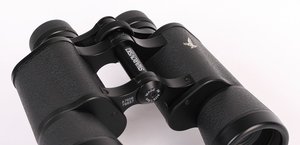Leupold BX-4 Pro Guide HD 8x42
The optical system, described shortly as HD, features fluorite elements that are supposed to ensure a perfect correction of chromatic aberration.
The producers claim that all optical elements of binoculars from this series are anti-reflection multi-coated. Apart from that, the surfaces of outer elements are covered by hydrophobic coatings and Schmidt-Pechan prisms are phase-correction coated.
The chassis of the binoculars is nitrogen-purged and waterproof. Buyers get in the box with the instrument: objective caps, a rainguard, a strap, a case, and a cleaning cloth for optics. The series comes with a lifetime warranty of the producer.
| Magnification | Lens diameter | Angular field of view | Prisms | Eye relief | Weight | Price |
|---|---|---|---|---|---|---|
| 8 | 42 | 123/1000(7o) | BaK-4/roof | 19 mm | 663 g | 2469 PLN |
Summary
Pros:
- shapely, lightweight casing made of magnesium composites,
- excellent correction of chromatic aberration,
- good correction of astigmatism,
- very good colour rendering,
- practically zero distortion,
- good blackening and cleanliness inside the tubes,
- almost round exit pupils,
- prisms made of BaK-4 glass,
- good quality anti-reflection coatings,
- lifetime warranty.
Cons:
- a lot of blurry areas on the edge of the field of view,
- parameters stated by the producers differ from reality,
- a bit too low transmission for this price point.
 |
That's why I got interested in the Leupold BX-4 Pro Guide HD 8X42, with a price tag of 500 USD, and I decided to test it thoroughly. Its field of view was not especially large but 7 degrees in this class is nothing to be ashamed of; what's more, a smaller field might mean very good aberration correction from edge to edge. You got also a very comfortable eye relief distance, amounting to as much as 19 mm. The binoculars, a very shapely instrument, were supposed to weigh just 663 grams. Finally, it's a product manufactured in Japan, something that happens less and less frequently nowadays when it comes to binoculars sold at this price point.
 |
The edge of the field of view is another matter. In the case of an 8x42 class binoculars, with a field of 7 degrees, you would expect a perfect correction; meanwhile the Leupold performs weakly when it comes to keeping good sharpness on the edge and you can have some reservations connected to coma correction as well. Additionally, at this price point you should also get transmission definitely closer to 90%.
 |
The real problem of the Leupold BX-4 Pro Guide HD 8x42 might be a fierce competition in this market segment. The Nikon Monarch 7 8x42 got practically the same result in our test and it is a device a tad cheaper and with a wider field of view. Binoculars such as the Bresser Pirsch ED 8x42 PhC or the Leupold BX-2 Alpine 8x42 got not much weaker results and they are cheaper as well. What's more, on the market you can find models that are cheaper than the Leupold and have fared better in our tests, for example the Bushnell Forge 8x42 or the Olympus 8x42 PRO. Compared to that, what's the selling point of the Leupold ? In fact, only its place of production – you can hope that a pair of binoculars, manufactured in Japan, undergoes a better process of quality control and, as a result, is more solid. Still, will it be indeed the case? Who knows...
To sum up, after the test I might say not all of my great expectations concerning the Leupold were met and it's a pity.

















